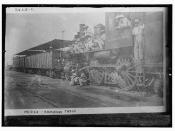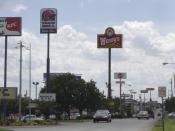Since its inception, KFC has evolved through several different organizational changes. These changes were brought about due to the changes of ownership that followed since Colonel Sanders first sold KFC in 1964. In 1964, KFC was sold to a small group of investors that eventually took it public. Heublein, Inc, purchased KFC in 1971 and was highly involved in the day-to-day operations. R.J. Reynolds then acquired Heublein in 1982. R.J. took a more laid-back approach and allowed business as usual at KFC. Finally, in 1986, KFC was acquired by PepsiCo, which was trying to grow its quick serve restaurant segment. PepsiCo presently runs Taco Bell, Pizza Hut, and KFC. The PepsiCo management style and corporate culture was significantly different from that of KFC. By the end of 1994, KFC was operating 4,258 restaurants in 68 foreign countries. KFC is the largest chicken restaurant and the third largest quick service chain in the world.
Due to market saturation in the United States, international expansion will be critical to increased profitability and growth.
The organization is currently structured with two divisions under PepsiCo. David Novak is president of KFC. John Hill is Chief Financial Officer and Colin Moore is the head of Marketing. Peter Waller is head of franchising while Olden Lee is head of Human Resources. KFC is part of the two PepsiCo divisions, which are PepsiCo Worldwide Restaurants and PepsiCo Restaurants International. Both of these divisions of PepsiCo are based in Dallas. Another strategy of KFC is currently working with is to improve operating efficiencies. This in turn can directly impact the operating profit of the firm. In 1989, KFC centered on elimination of overhead costs and increased efficiency. This reorganization was in the U.S. operations and included a revision of KFC's crew...


